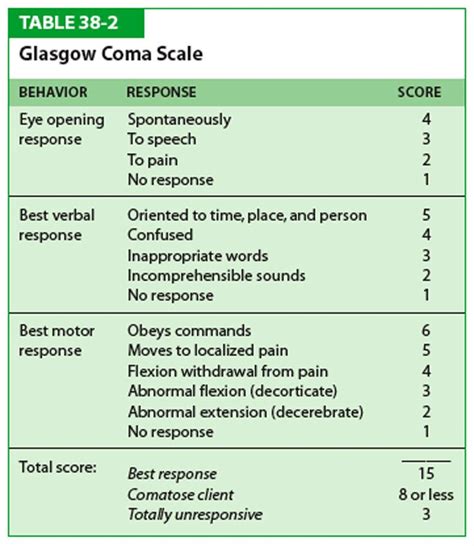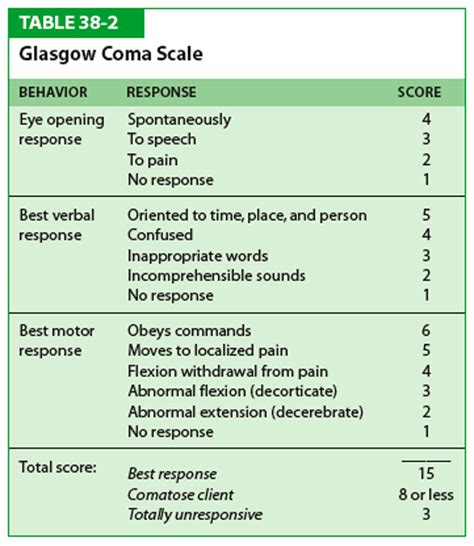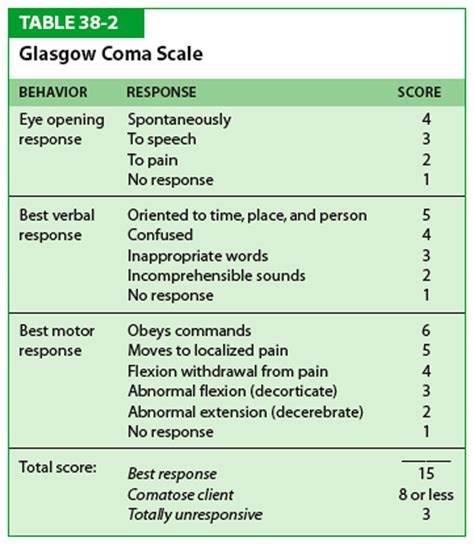Unlock the nuances of neurological assessments with our exploration of Glasgow Coma Scale vs. NIHSS. Gain insights that empower healthcare professionals and enhance patient care.
In the dynamic landscape of healthcare, understanding the nuances of assessment tools is paramount. The comparison between the Glasgow Coma Scale (GCS) and the National Institutes of Health Stroke Scale (NIHSS) stands as a critical exploration within this realm. As healthcare professionals strive to provide comprehensive care, the differentiation between these two widely used scales becomes imperative. This article delves into the distinct characteristics of the GCS and NIHSS, shedding light on their unique roles in evaluating patients' neurological status. In navigating this discourse, we embark on a journey to grasp the significance and applications of these assessment tools, aiming to empower both practitioners and the broader community with valuable insights into neurologic evaluations.
Top 10 Points about Glasgow Coma Scale vs. NIHSS :
- Understanding the Purpose of Neurological Assessment Scales
- Exploring the Glasgow Coma Scale: A Comprehensive Overview
- Navigating the National Institutes of Health Stroke Scale (NIHSS)
- Comparative Analysis: GCS and NIHSS Scoring Systems
- Interpreting GCS Scores in Neurological Evaluations
- Decoding NIHSS Scores: Significance in Stroke Assessment
- Applications in Real-world Healthcare: GCS vs. NIHSS
- Challenges and Limitations of Glasgow Coma Scale
- Insights into NIHSS: A Critical Examination of Its Components
- Strategies for Integrating GCS and NIHSS for Holistic Patient Care
Several facts about Glasgow Coma Scale vs. NIHSS
Neurological assessments play a pivotal role in healthcare, aiding professionals in evaluating and managing patients with various conditions. Among the prominent tools employed, the Glasgow Coma Scale (GCS) and the National Institutes of Health Stroke Scale (NIHSS) stand out. These two assessments, while serving distinct purposes, contribute significantly to the comprehensive evaluation of neurological status.
Understanding the Purpose of Neurological Assessment Scales
Neurological assessment scales are indispensable tools that healthcare professionals utilize to gauge a patient's neurological status accurately. The primary objective is to provide a standardized and objective measure, aiding in effective communication among healthcare providers and ensuring consistent patient care.
Exploring the Glasgow Coma Scale: A Comprehensive Overview
The Glasgow Coma Scale (GCS) serves as a fundamental tool for assessing a patient's level of consciousness. It comprises three components—eye, verbal, and motor responses—each assigned a score. By evaluating these responses, healthcare professionals obtain a cumulative score that aids in categorizing the severity of neurological impairment.
Navigating the National Institutes of Health Stroke Scale (NIHSS)
The National Institutes of Health Stroke Scale (NIHSS) is specifically tailored to assess patients with stroke symptoms. It comprises various components, each targeting specific neurological functions. Scores obtained from these components assist healthcare providers in determining the severity of a stroke and guiding appropriate intervention strategies.
Comparative Analysis: GCS and NIHSS Scoring Systems
A critical examination of the scoring systems of GCS and NIHSS reveals both similarities and differences. While GCS assesses broader aspects of consciousness, NIHSS focuses on specific neurological deficits associated with stroke. Understanding these nuances is essential for healthcare professionals to choose the appropriate tool based on the clinical context.
Interpreting GCS Scores in Neurological Evaluations
The interpretation of GCS scores requires a nuanced understanding of the three components. Higher scores indicate a more favorable neurological status, while lower scores suggest a greater impairment. This information is crucial for clinicians to communicate effectively and make informed decisions about patient care.
Decoding NIHSS Scores: Significance in Stroke Assessment
For healthcare providers dealing with stroke cases, understanding the significance of NIHSS scores is paramount. The scale not only aids in determining the severity of a stroke but also guides the selection of appropriate interventions. This precision is crucial for optimizing patient outcomes and minimizing long-term neurological damage.
Applications in Real-world Healthcare: GCS vs. NIHSS
Understanding how to apply both the GCS and NIHSS in real-world healthcare scenarios is essential. While GCS is more versatile in assessing a broader range of neurological conditions, NIHSS excels in stroke-specific evaluations. The judicious use of these tools enhances diagnostic accuracy and guides appropriate treatment strategies.
Challenges and Limitations of Glasgow Coma Scale
Despite its widespread use, the Glasgow Coma Scale is not without its challenges and limitations. These include subjectivity in scoring, cultural and linguistic variations, and potential interrater variability. Acknowledging these limitations is crucial for healthcare professionals to interpret GCS scores accurately and make informed clinical decisions.
Insights into NIHSS: A Critical Examination of Its Components
A deeper exploration of the components of the NIHSS unveils the specific neurological functions it assesses. Each component corresponds to a particular aspect of stroke-related deficits, allowing healthcare providers to tailor interventions based on the observed symptoms. This granular approach enhances the precision of diagnosis and treatment planning.
Strategies for Integrating GCS and NIHSS for HolGlasgow Coma Scale vs. NIHSS in Professional's eye
In the realm of healthcare, the comparison between the Glasgow Coma Scale (GCS) and the National Institutes of Health Stroke Scale (NIHSS) has emerged as a critical discourse for professionals dedicated to neurological assessments. These standardized tools play pivotal roles in evaluating patients, aiding in the diagnosis, and informing treatment strategies. A comprehensive understanding of the GCS reveals its versatility, encompassing a broader range of neurological conditions. The GCS, with its three components—eye, verbal, and motor responses—provides a cumulative score that categorizes the severity of neurological impairment. However, it is essential to acknowledge the challenges and limitations associated with the GCS, including subjectivity in scoring and potential cultural variations. This nuanced awareness ensures accurate interpretation and application in clinical settings.






Point of Views : Glasgow Coma Scale vs. NIHSS
Introduction:Neurological assessments are integral to healthcare, aiding in the evaluation and management of patients with diverse conditions.The Glasgow Coma Scale (GCS) and the National Institutes of Health Stroke Scale (NIHSS) are prominent tools employed in neurological evaluations.Glasgow Coma Scale Overview:The GCS, comprising eye, verbal, and motor responses, provides a cumulative score categorizing the severity of neurological impairment.It offers a versatile approach, assessing a broad range of neurological conditions.NIHSS Overview:Specifically designed for stroke assessments, the NIHSS targets various neurological functions, aiding in determining stroke severity.This scale excels in providing a focused evaluation for stroke-specific deficits.Comparative Analysis:A comprehensive examination of the GCS and NIHSS scoring systems reveals both similarities and differences.GCS assesses overall consciousness, while NIHSS focuses on specific deficits associated with stroke.Interpreting GCS Scores:GCS scores are interpreted based on three components, with higher scores indicating a more favorable neurological status.The interpretation is essential for effective communication among healthcare providers and informed decision-making.Decoding NIHSS Scores:NIHSS scores are decoded to determine stroke severity and guide the selection of interventions.This precision minimizes long-term neurological damage and optimizes patient outcomes.Real-world Applications:The versatile GCS proves beneficial in assessing a broad spectrum of neurological conditions.NIHSS excels in stroke-specific evaluations, enhancing diagnostic accuracy and guiding appropriate treatment strategies.Challenges and Limitations of GCS:Subjectivity in scoring, cultural variations, and potential interrater variability pose challenges in GCS application.Recognizing these limitations is crucial for accurate interpretation and clinical decision-making.Insights into NIHSS Components:A deeper exploration of NIHSS components provides insights into specific neurological functions assessed.This granular approach enhances the precision of diagnosis and treatment planning.Strategies for Integration:Integrating GCS and NIHSS requires a nuanced approach, considering the strengths and limitations of each tool.Developing cohesive strategies ensures comprehensive neurological assessments and tailored interventions.Conclusion:A holistic perspective on GCS and NIHSS integration contributes meaningfully to diagnostic accuracy and patient care.Professionals must adeptly interpret scores, recognizing the clinical context for optimal utilization.Conclusion :As we conclude our exploration of the Glasgow Coma Scale (GCS) versus the National Institutes of Health Stroke Scale (NIHSS), it becomes evident that these neurological assessment tools play indispensable roles in the healthcare landscape. Our journey through the intricacies of these scales has unveiled their distinct purposes, from the GCS's versatile evaluation of various neurological conditions to the NIHSS's focused approach in stroke assessments. Recognizing the strengths and limitations of each tool is paramount for healthcare professionals, ensuring accurate interpretations and informed decision-making in patient care.
Whether you are a seasoned healthcare practitioner or an inquisitive reader seeking insights into neurological assessments, our exploration has aimed to provide a nuanced understanding of the GCS and NIHSS. As you navigate the complexities of these tools, remember that their strategic integration can contribute significantly to comprehensive evaluations and tailored interventions. Stay informed, stay curious, and continue prioritizing the well-being of those under your care by leveraging the knowledge gained from our exploration of the Glasgow Coma Scale versus the NIHSS. Your commitment to understanding these assessment tools enhances the quality of healthcare delivery and underscores the importance of continuous learning in the dynamic field of medicine.
Questions and Answer for Glasgow Coma Scale vs. NIHSS
As we conclude our exploration of the Glasgow Coma Scale (GCS) versus the National Institutes of Health Stroke Scale (NIHSS), it becomes evident that these neurological assessment tools play indispensable roles in the healthcare landscape. Our journey through the intricacies of these scales has unveiled their distinct purposes, from the GCS's versatile evaluation of various neurological conditions to the NIHSS's focused approach in stroke assessments. Recognizing the strengths and limitations of each tool is paramount for healthcare professionals, ensuring accurate interpretations and informed decision-making in patient care.
Whether you are a seasoned healthcare practitioner or an inquisitive reader seeking insights into neurological assessments, our exploration has aimed to provide a nuanced understanding of the GCS and NIHSS. As you navigate the complexities of these tools, remember that their strategic integration can contribute significantly to comprehensive evaluations and tailored interventions. Stay informed, stay curious, and continue prioritizing the well-being of those under your care by leveraging the knowledge gained from our exploration of the Glasgow Coma Scale versus the NIHSS. Your commitment to understanding these assessment tools enhances the quality of healthcare delivery and underscores the importance of continuous learning in the dynamic field of medicine.
People Also Ask about Glasgow Coma Scale vs. NIHSS:
-
1. What is the primary purpose of the Glasgow Coma Scale (GCS)?
The primary purpose of the GCS is to provide a standardized and objective measure for assessing a patient's level of consciousness. It encompasses three components—eye, verbal, and motor responses—assigning scores to each. This cumulative score aids healthcare professionals in categorizing the severity of neurological impairment, facilitating communication and guiding appropriate interventions.
-
2. How does the National Institutes of Health Stroke Scale (NIHSS) differ from the Glasgow Coma Scale?
The NIHSS is specifically designed for assessing patients with stroke symptoms, focusing on specific neurological deficits associated with stroke. In contrast, the GCS has a broader application, evaluating various neurological conditions beyond stroke. While both scales involve scoring systems, their distinct purposes cater to different clinical scenarios, requiring healthcare professionals to choose the appropriate tool based on the context.
-
3. Can GCS and NIHSS be used interchangeably for any neurological assessment?
No, GCS and NIHSS are not interchangeable for all neurological assessments. GCS is versatile and applicable to a broader range of neurological conditions, while NIHSS is tailored specifically for stroke assessments. The choice between these tools depends on the clinical context, with healthcare professionals strategically selecting the most appropriate scale based on the patient's presenting symptoms and medical history.
-
4. Are there any limitations to consider when using the Glasgow Coma Scale?
Yes, there are limitations associated with the GCS. These include subjectivity in scoring, cultural and linguistic variations, and potential interrater variability. Healthcare professionals should be aware of these challenges to interpret GCS scores accurately and consider supplementary information for a comprehensive neurological assessment.
-
5. How do healthcare professionals integrate GCS and NIHSS for patient care?
Healthcare professionals integrate GCS and NIHSS by recognizing the strengths and limitations of each tool. GCS may be used for initial assessments, providing a broad overview of neurological status, while NIHSS excels in stroke-specific evaluations. Strategic integration involves considering both scores, clinical context, and additional information to formulate comprehensive care plans tailored to the individual patient's needs.
Label :GCS, NIHSS, Neurological Assessments
Keyword : Glasgow Coma Scale vs. NIHSS
0 komentar